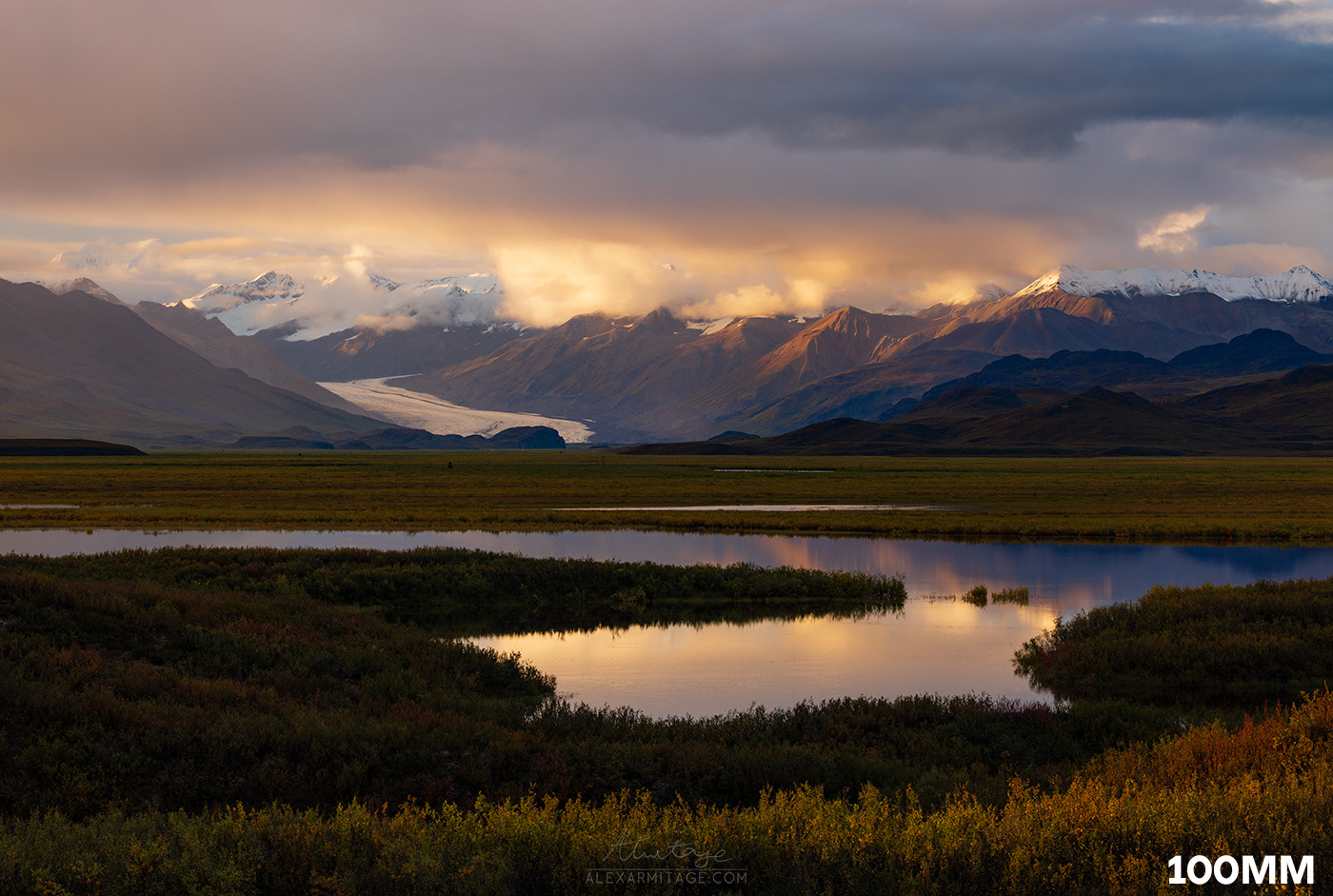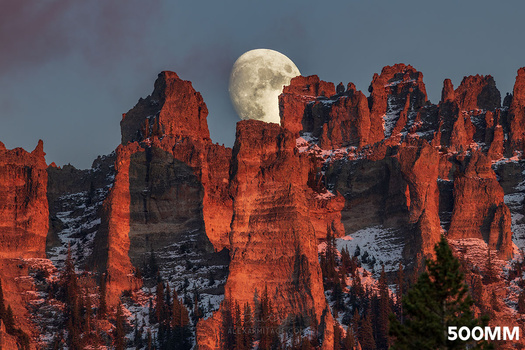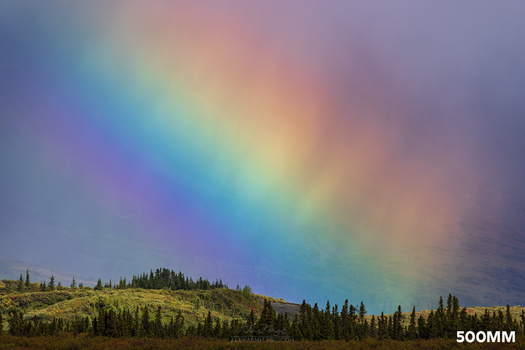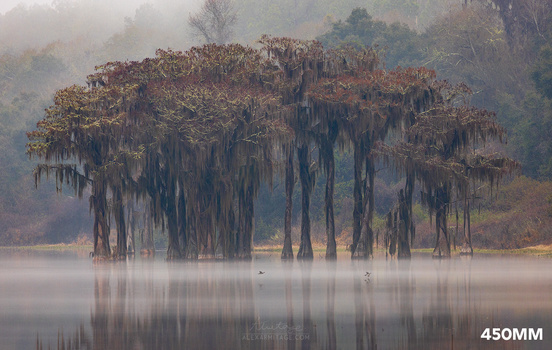Last summer I bought a super telephoto lens to capture wildlife in Alaska. After more than half a year of using it as a lens for landscape photography, was it worth it?
For most of my photography career, I’ve shot with a very minimal kit in different variations: a camera, 16-35mm super-wide, and a 70-200mm telephoto. That’s been my bread and butter for so long that adding anything else almost felt like I was going against my minimalist roots. However, when I started creating YouTube videos full time it required a second camera, another tripod, and a drone. At that point I realized I wasn’t much of a minimalist anymore and that my kit could simply be malleable based on the task; shooting from my vehicle, going for a hike, or an involved trip.
When I drove to Alaska to live there for a few months this past summer, I knew I couldn’t go there without something to capture wildlife with. Renting a lens for roughly 3 months was out of the question considering the price. When I realized if I could get my hands on a Canon RF 100-500mm that I could simply resell it after the excursion for a small loss, it became no question.
Spoiler: I still have the lens…
The Good
Most of my evaluation of this lens is regarding the super telephoto capabilities in landscape photography. Specifically, anything beyond 200mm so as to not overlap with a standard 70-200mm telephoto lens. That being said, I cannot write about this lens without highlighting its versatility. Yes, it’s a superzoom but it does still cover the more standard 100-200mm range as well. This means that when I’m driving around looking for compositions, which I do far more than the average person considering I live on the road taking photos. The RF 100-500mm has become my driving lens over my Canon RF 70-200mm f/4 for this simply because it gives me a lot more versatility.
This versatility continues in almost any scene with compositions at a distance. It doesn’t matter if I’m on a mountaintop in Alaska or the swamps of Florida, the variable reach of the lens is spoiling. It means every little scene in the distance is a potential composition. It can also mean little details around you become enlarged and brought to life.
Outside of versatility, the superzoom range gives you the ability to capture scenes that simply are not possible without the reach. The gallery above are a few photos from the past 6 months that I wouldn’t have been able to capture without this range, each listed with their focal distance. The photo of the moon rising over the peaks is not an image you can take without the compression of a superzoom. The quickly changing light on the cypress trees as I sat in a kayak would have been completely gone by the time I rowed myself close enough to each of those compositions.
Above is Denali at 100mm and 500mm. I think the comparison speaks for itself in just how much distance you can cover with a single lens.
Lastly, the stabilization of the Canon RF 100-500mm specifically is actual magic. While it’s not landscape photography related, being able to film video at 500mm handheld for my YouTube content and also get sharp photos when there isn’t much light to work with such as the cypress trees above, it cannot go unmentioned.
All of these come at a cost though, and I don’t just mean price.
The Bad
Sometimes too many options cause decision fatigue and you end up struggling to shoot anything simply because you have too many options. While the versatility of the lens is paramount, it comes at the cost of allowing you to shoot anything and everything.

When it comes to landscapes I found that the super zoom range was actually too much zoom. In many scenes past 250mm you lose perspective and key compositional elements within your scene. To top it off you start having atmospheric challenges. Roughly around 300mm I noticed that a majority of the time, things you’re trying to capture in the distance are so far away that you get atmosphere haze and a “mirage” effect causing your images to become blurry. It takes very special conditions anytime you’re photographing through a lot of distance to not run into this issue which effectively makes the superzoom range unreliable.

The more obvious negative points here are size and weight. This will vary depending on what lens you might be using specifically, but I have to admit that the RF100-500mm I have isn’t all that much different in both size and weight from my old Canon EF 70-200 f/2.8 that I used for 10 years. That being said when you compare it to the new Canon RF70-200mm f/4, it becomes much more of a talking point. Most lenses in this range though, especially the more budget-friendly options are larger and heavier.
The Ugly
Do I recommend this focal range for landscape photography? No, I do not recommend it strictly for landscape photography. However, everyone’s situation is different. If you have an interest in photographing wildlife and you can double-dip into both use cases then it becomes a lot more reasonable. If you already have every other lens you could possibly want and it’s the last range you don’t have - go for it. If you need the range because you’re interested in compressed shots like the moon - that’s a niche where superzooms are a necessity.

But if you’re like many people and looking to get your first telephoto lens, I wouldn’t recommend trying to cover it all with a super zoom such as the RF100-500mm. Tamron just released a 50-400mm which seems absolutely amazing for versatility but I’d still recommend a smaller zoom range first. It’ll be lighter weight, have a sharper image, and most of all you’ll still capture 90% of the images you'd capture simply because the superzoom range doesn't get utilized enough for Landscape Photography.
If I were to summarize my experience in one sentence it would be that once you go past the 250mm mark you quickly lose value in your investment. That investment could be the size and weight you're managing or the actual cost of the lens.

Am I going to get rid of my Canon RF 100-500mm? Definitely not as it provides me with a plethora of benefits being both a photographer and videographer. Remember it's always about your own personal goals and what you want out of your photography. I'd love to know your thoughts on the superzoom range. If you could only have one lens in your kit, what would it be? What about two lenses? As always thanks for reading!













I've been using a 200-500 f/5.6 for landscapes for years.
No offense intended, but the Canon RF100-500 hardly qualifies as a "super telephoto lens". That term is usually reserved to primes at 400mm and above, assuming they offer wide apertures. Examples: 400 f/2.8, 500 f/4, 600 f/4, 800 f/5.6, etc. There are a few zooms in this category, too, such as the Nikon 180-400, Canon and Nikon 200-400, and Olympus 150-400. Most of them cost an arm and a leg, some actually TWO arms and legs. ;-)
The RF100-500 is a good lens, though a bit on the pricey side. Nevertheless, it does not play in the same league, sharpness-wise and from a bokeh perspective, as the "supers", which makes this video a bit misleading.
I was under the impression that "super telephoto" was basically anything past 300MM, and was irrelevant to the aperture. At least in my use here, i'm only talking about the focal distance - not the image quality.
Totally willing to be educated here!
Don't feel the need to be "educated."
Wikipedia (https://en.wikipedia.org/wiki/Telephoto_lens) and Adorama (https://www.adorama.com/alc/wide-angle-vs-telephoto-which-lens-should-yo...) agree with you: a "super-telephoto" is anything over 300mm (or full-frame equivalent field of view).
Googling for "supertelephoto definition" did not return a single first-page hit that included anything except focal length for this definition.
I think the term Lon and Tom are reaching for is "fast super-telephoto."
Good info! Thanks Jan
Luis,
I completely agree. The folks who use true supertelephotos all the time, as their primary everyday lenses, would never consider the little 100-500 zoom to be a supertelephoto. Hardcore and/or full time wildlife and bird photographers are the ones who get to determine such terms, because they are the ones who depend on these class of lenses to meet their needs on an everyday basis.
People who do "normal" photography most of the time seem to have different ideas about telephoto lenses, but I don't think those ideas are based on decades of experience using truly long focal lengths on a regular basis.
I am definitely presenting a "gatekeeper" perspective here, but we need some gatekeeping in order to keep things straight and not have pedestrian lenses confused with the true supertelephotos.
Little provocation: for the price of that lense, and if landscape is your goal, you can buy a drone that actually takes you there, not only closer, but with much more options ;)
Depends on where you are and what you're trying to accomplish. It goes without saying that a drone takes completely different style of photos!
On my last trip I only had 2 lenses: 24-105 and 200-600. The 200-600 got the most use (like, 95+%).
Even for photos of snakes and larger spiders, the 200-600 was my go to. I think that I'd struggle to justify a 70-200 any more.
I agree. I never travel with my 70-200 f/2.8. I use the lens for indoor sports and indoor events. I travel with my 15-35, 24-105 and 100-500 and 1.4x. Depending on the location and the subject will determine the lens. The 24-105 is my most used day to day lens.
Nt
.
Alex,
Thanks for sharing about your own personal experiences with a telephoto zoom. This was so much better than just a few words and a link to some YouTube video.
Personally, I don't consider the 100-500mm to be a supertelephoto. To me, what puts the "super" in supertelephoto is a very large entrance pupil, such as we have on a 600mm f4, 800mm f5.6, 400mm f2.8, etc. So the way most hardcore wildlife photographers use the word "supertelephoto", a 400mm f5.6 is NOT a supertelephoto, while a 400mm f2.8 is a supertelephoto. Similarly, the new Canon 800mm f11 is not a supertelephoto, while the Sigma 300-800mm f5.6 is a supertelephoto. A 300mm f2.8 is not a supertelephoto because even though it has a relatively large aperture, it is simply too short of a focal length to be considered a supertelephoto.
Most of the folks I know and shoot with use a true supertelephoto as their main lens, and then carry a 100-400 or 100-500 in their bag as a "little" lens for when things get real close or when they want to shoot a landscape shot or something. This is what I do - I have a few true supertelephotos, and then I keep the little 100-400mm zoom in my pack in case something very close by presents an unexpected opportunity.
.
Interesting info! What would you name/call the zoom range past 300MM generally then? Is there another word for it?
Most of the folks in the circles I frequent simply refer to a long lens as a "telephoto", unless it is a truly big lens, then "supertelephoto" may be used from time to time. "Big Whites" is what many people use when referring to Canon's supertelephotos, but that term is normally only used for the true supertelephotos, not the relatively little 100-400/500mm zooms.
We all have different definitions. I just did a Google Search on super Telephoto and B&H and many others definitely lists the RF 100-500, they even include the EF 100-400. Doing a further Google search I see the Sigma and Tamron 150-600 listed in my results.
I would probably break into two categories - Super Telephoto zoom lenses and Super Telephoto prime lenses.
Because super-tele zooms add weight, add cost, reduce aperture, and reduce sharpness over primes, I prefer my super-teles to be prime.
Yes, this is less versatile, and you often have to "search for" composition or change location, rather than simply twist a ring, but I've been less-thrilled with every super-tele zoom I've tried, compared to the super-tele primes I've tried.
(OM Zuiko 350mm ƒ/2.8 with OM 14X-A teleconverter on Micro Four Thirds, for an effective 1,000mm field-of-view.)
Agree to a large degree. Up until five or so years ago, I would have agreed all the way. Lately, however, zooms have been introduced that rival primes in terms of sharpness. You find some of them in the WA and standard ranges (e.g., Nikon Z14-24 and Z24-70 f/2.8). In the supertele field, those I named earlier (Nikon 180-400, Nikon and Canon 200-400, Olympus 150-400) only meet one of your criteria: they add cost. ;-)
(Olympus 150-400 with built-in TC engaged, at an effective 890mm field-of-view. Shot hand-held from a moving boat. This lens is HALF the weight of the OM Zuiko 350mm.)
On personality types and focal lengths… from years of teaching photography classes, my totally non-scientific observation is that is that extroverts tend to prefer wide-angle, and introverts tend to prefer macro and telephoto.
What do *you* think? Does this describe *you?*
I'd urge my students to push their boundaries, by trying at least one lesson shooting the opposite field-of-view than they'd normally be drawn to — with some interesting results!
Jan,
What an interesting observation!
I've mainly used telephotos, often supertelephotos, as the long focal lengths fit the subject matter that I try to shoot.
But whenever a rare opportunity arises to get super close to a wild animal, I relish the chance to shoot it with a wide angle at point-blank range! In fact I even have a "wide angle wildlife" album on my Flickr account.
I have 300-800mm and 60-600mm lenses, but the next lenses I buy will be the Laowa 15mm macro lens and the Laowa 25mm Macro Probe lens.
I've taken a bunch of those introvert / extrovert tests, and I have strong tendencies for both sides. Out of every ten tests I take, 4 to 6 will show that I am an extrovert, and 4 to 6 will show that I'm an introvert.
So my lens preferences do mirror my personality type, just as you suggested!
Don't know. Am I more extroverted when shooting landscapes, and rather introverted when shooting birds, both of which I like a lot? I'll have to think about that... ;-)
Ok, seriously now: when it comes to shooting subjects such as people or street, your thought makes a lot of sense to me. I shoot neither, which probably tells you something about me. On the other hand, I am also on both sides of the spectrum, as several Meyers-Briggs assessments told me. Photography is my "introverted hobby" - but I also enjoy being among people. I just don't use my camera then.
What is your personality type when you like all focal ranges?
Guess you're an "ambivert". :-)
The 'good' aspects of super-teles, 300mm and above, speak for themselves. As for the 'bad' aspects....atmospheric haze and mirages are effects that can be utilized for specifically that reason, to show how hot it is for example or to indicate that someone is "seeing things" via a mirage. So bad would not be an adjective for these purposes. As for decision fatigue...screw that. I never in my life had that experience and never will. If someone does then they don’t need to be holding a camera. The highest I go on a tele zoom is up to 200mm. Anything beyond I use straight fixed focus super teles.
Not to pile on, but I mainly do wildlife photography with a Canon 600 f4 prime, so that to me is a "super telephoto." I don't own the particular lens discussed herein, but I do have the Canon 100-400 zoom, which is in the ballpark of the lens here, and both I would consider to be little lenses for when I need a bit more mobility. I would also note that for instances where you might have a bit too much lens for a landscape opportunity, you can always consider multi-frame panoramas to be stitched together later in your software of choice.
One last thing. For some reason, people seem to think that if you have a "super telephoto," all you will shoot are mountains a mile off in the distance. At least for me, I rarely shoot anything way off in the distance. Rather, I use a 600mm so, for example, I can fill the frame with a small bird 40 feet away and get good feather detail.
"I rarely shoot anything way off in the distance."
So true!
Whatever you get, make sure it focuses close! A lot of super-teles — especially older ones — don't seem to focus closer than half a football field!
If it focuses close, you have a candid portrait lens!
(Olympus OM Zuiko 500mm ƒ/8 Reflex, on Micro Four Thirds, effective 1,000mm field of view.)
That is what I love about the Canon 400mm f2.8 - the short minimum focus distance of 10 feet allows you to do some nice close-up work. Put 1.4x or 2.0x tele-extender on the 400f2.8 and the minimum focus distance is STILL 10 feet, so you get even more magnification for close-up work!
Wild Turkey head shot, uncropped, taken with the 400f2.8n and 2.0x tele-extender.
I have no doubt the 400/2.8 is amazing, pretty sure I will never afford one. I always like your work Tom.
I really enjoy my RF 100-500, easily the best lens I have ever owned (and the most expensive. The MFD for the lens is good - At 100mm: 2.95 ft. / 0.9m
At 300 mm: 3.28 ft. / 1m and At 500mm: 3.94 ft. / 1.2m.
If I were to have just one lens it would be my 24-105 f4L , with two probably a 16-35 and a 100-400. Liked the article.
I used to be the same until I got my 200-600. Now if I had to have just one lens, that'd be it. For 2 lenses, I'd also have a 24-105.
Why did you give my first comment a thumbs down? What did I say in that comment that you disagree with?
I don't quite get the idea of certain focal-length ranges being "overrated" or not. 300mm and up lenses are not the most commonly needed, but if you're photographing wildlife, or certain sports, etc; they're invaluable.
If you're shooting headshots, or street photography, or products; not so much.
Are hex wrenches overrated? If you don't need one, you don't need one. But if you have hex screws to loosen, you'll need one.
Even up close, 600mm is sometimes useful.
I saw a Wagler's Viper on holiday. The 24-105 couldn't get close enough without major crop, but the 200-600 @ 600 was excellent for framing. DoF was a challenge though, but a worthwhile payoff vs a severe crop.
You say you bought the 100-500 as a wildlife lens, but then talk about its pros and cons as a landscape lens. This is obviously not designed as a landscape lens (though any lens may be used as one), so it will have its failings, but can hardly be said to be overrated, unless it failed to get you good wildlife shots. A wildlife lens that can occasionally be used for portraits or landscapes is how the 100-400 should be looked at, and in that light, the cons should be portability rather than composition, since you're not using it as it was (or you) intended it to be used.
Portability is one of the reasons I really like the 100-500. Until recently I really did not worry about the size and weight of my gear, but as I get older I find weight important. The lens weights 3 lbs. and I find this great. I also like the size, fits really nicely in my travel backpack.
The major negative of the lens is the limitations using a RF TC. The lens can only use the 300-500 range. Does not really bother me in shooting, but does make the lens a little longer to carry.
I use my EF 100-400mm MII on my R7 for both wildlife and landscapes.
Would like the extra 100mm but not worth the extra for a hobbyist like me.
Good article.